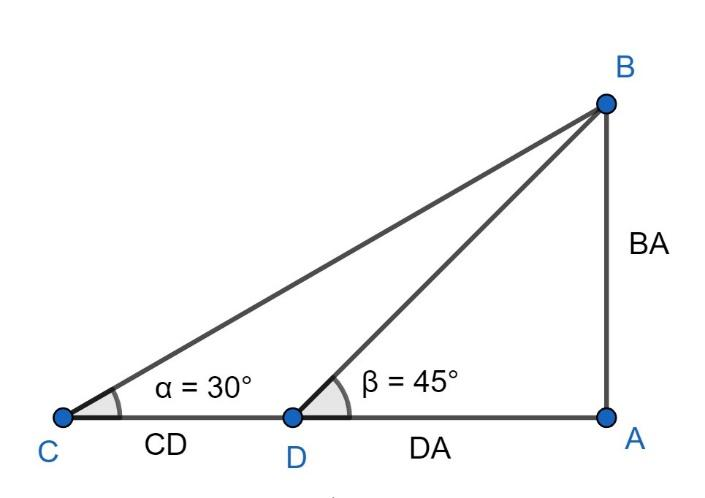Question
Question: The length of the shadow of a tower standing on level ground is found to be \(2x\) metres longer whe...
The length of the shadow of a tower standing on level ground is found to be 2x metres longer when the sun’s elevation is 300 than when it was 450 . The height of the tower in metres is.
(a) (3+1)x
(b) (3−1)x
(c) 23x
(d) 32x
Solution
Hint: For solving this problem first we will draw the geometrical figure as per the given data. After that, we will use the basic formula of trigonometry tanθ=(length of the base)(length of the perpendicular) . Then, we will solve correctly to get the height of the tower and select the correct option.
Complete step-by-step answer:
Given:
It is given that the length of the shadow of a tower standing on level ground is found to be 2x metres longer when the sun’s elevation is 300 than when it was 450 . And we have to find the height of the tower.
Now, first, we will draw a geometrical figure as per the given data. For more clarity look at the figure given below:

In the above figure BA represents the height of the tower, DA represents the length of the shadow of the tower when the elevation of the sun is equal to ∠BDA=β=450 and CA represents the length of the shadow of the tower when the elevation of the sun is equal to ∠BCA=α=300 .
Now, as it is given that length of the shadow of a tower standing on level ground is found to be 2x metres longer when the sun’s elevation is 300 than when it was 450 . Then,
CA=DA+2x...................(1)
Now, consider ΔBDA in which ∠BAD=900 , DA is equal to the length of the base, BA is equal to the length of the perpendicular and ∠BDA=β=450. Then,
tan(∠BDA)=(length of the base)(length of the perpendicular)⇒tan450=DABA⇒1=DABA⇒DA=BA................................(2)
Now, consider ΔBCA in which ∠BAC=900 , CA is equal to the length of the base, BA is equal to the length of the perpendicular and ∠BCA=α=300. Then,
tan(∠BCA)=(length of the base)(length of the perpendicular)⇒tan300=CABA⇒31=CABA⇒CA=3(BA)................................(3)
Now, substitute DA=BA from equation (2) and CA=3(BA) from equation (3) into equation (1). Then,
CA=DA+2x⇒3(BA)=BA+2x⇒BA(3−1)=2x⇒BA=(3−1)2x⇒BA=(3−1)2x×(3+1)(3+1)
Now, as we know that (a−b)(a+b)=a2−b2 so, we can write (3−1)(3+1)=(3)2−12 in the above equation. Then,
BA=(3−1)2x×(3+1)(3+1)⇒BA=((3)2−12)2x(3+1)⇒BA=(3−1)2x(3+1)⇒BA=22x(3+1)⇒BA=x(3+1)
Now, from the above result, we conclude that the length of the BA will be x(3+1) metres.
Thus, the height of the tower will be x(3+1) metres.
Hence, (a) is the correct option.
Note: Here, the student should first try to understand what is asked in the problem. After that, we should try to draw the geometrical figure as per the given data. Moreover, we should apply the basic formula of trigonometry properly without any error and avoid calculation mistakes while solving to get the correct answer and then select the correct option.
